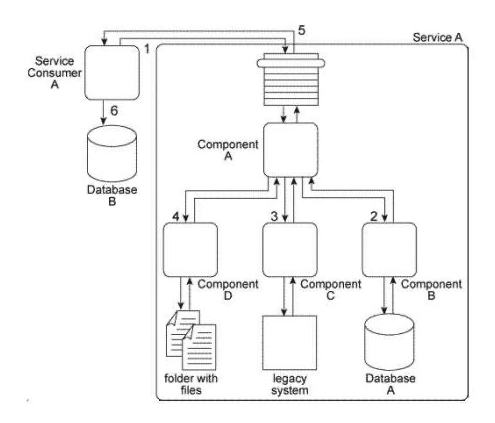When Service A receives a message from Service Consumer A(1) ,the message is processed by Component A. This component first invokes Component B (2) , which uses values from the message to query Database A in order to retrieve additional data. Component B then returns the additional data to Component A. Component A then invokes Component C (3) , which interacts with the API of a legacy system to retrieve a new data value. Component C then returns the data value back to Component A. Next, Component A sends some of the data it has accumulated to Component D (4) , which writes the data to a text file that is placed in a specific folder. Component D then waits until this file is imported into a different system via a regularly scheduled batch import. Upon completion of the import, Component D returns a success or failure code back to Component A. Component A finally sends a response to Service Consumer A (5) containing all of the data collected so far and Service Consumer A writes all of the data to Database B (6) . Components A, B, C. and D belong to the Service A service architecture. Database A, the legacy system, and the file folders are shared resources within the IT enterprise.  Service A is a task service that completes an entire business task on its own without having to compose other services. However, you have received many complaints about the reliability of Service A . Specifically, it has three problems. First, when Component B accesses Database A, it may not receive a response for several minutes when the database is being accessed by other applications in the IT enterprise. Secondly, the legacy system accessed by Component C frequently crashes and therefore becomes unavailable for extended periods of time. Third, for Component D to respond to Component A, it must first wait for the batch import of the files to occur. This can take several minutes during which Service Consumer A remains stateful and consumes excessive memory. What steps can be taken to address these three problems?
Service A is a task service that completes an entire business task on its own without having to compose other services. However, you have received many complaints about the reliability of Service A . Specifically, it has three problems. First, when Component B accesses Database A, it may not receive a response for several minutes when the database is being accessed by other applications in the IT enterprise. Secondly, the legacy system accessed by Component C frequently crashes and therefore becomes unavailable for extended periods of time. Third, for Component D to respond to Component A, it must first wait for the batch import of the files to occur. This can take several minutes during which Service Consumer A remains stateful and consumes excessive memory. What steps can be taken to address these three problems?
Definitions:
Debt to Equity
A financial ratio indicating the relative proportions of shareholders' equity and debt used to finance a company's assets.
Ownership of Partnership
Ownership of a partnership refers to the proportionate share of rights, interests, and responsibilities in a partnership business, held by each partner.
Bonita's Share
A specific portion or allotment of a larger amount or entity that is designated or attributed to a person named Bonita.
Whole Business
A term often used in finance and economics referring to considering all aspects and operations of a business entity as a total entity.
Q8: In which config areas are layout files
Q14: Which is the following is For Profit
Q41: Which two elements are the major causes
Q48: Which of the following statements are false?<br>A)
Q51: Which advantage do SNMP traps and Syslog
Q52: Which of the following statements is true?<br>A)
Q56: You have used the "refresh"' action on
Q62: You are installing an OLTP application on
Q68: You are using a protocol analyzer to
Q88: Companies A and B have merged and